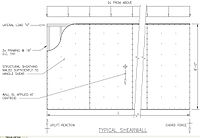
Photo from wikipedia
This paper presents a micromechanics-based 3D finite element model for predicting the damage initiation, propagation, and failure strength of TC33/Epoxy carbon fiber reinforced polymer (CFRP) unidirectional lamina under biaxial loadings.… Click to show full abstract
This paper presents a micromechanics-based 3D finite element model for predicting the damage initiation, propagation, and failure strength of TC33/Epoxy carbon fiber reinforced polymer (CFRP) unidirectional lamina under biaxial loadings. The finite element model is generated by introducing representative volume element (RVE) with a random distribution of fibers and a non-zero thickness, numerically identified interface phase via cohesive elements. In the finite element model, the carbon fibers are considered as elastic, while the elasto-plastic behavior and damage of the matrix are governed by extended Drucker–Prager plastic yielding model and ductile damage criterion. By imposing periodic boundary conditions to the RVEs, various cases subjected to uniaxial and biaxial loading conditions are carried out. During the combined transverse and in-plane shear stress states, a failure transition from compression- or tension-dominated to shear-dominated is captured, and the effects of the interfacial strength on the transition damage mechanisms are discussed. The corresponding failure locus is compared with the upper bound and lower bound predictions of three phenomenological failure criteria (Hashin, Tasi–Wu, and Puck failure criteria) for composites. It was found that in the interface-dominated failure of a CFRP lamina with a weak interface, the Hashin failure criterion performs best among the currently popular failure criteria. However, in the matrix-dominated failure with a strong interface, the Puck failure criterion performs best. Comparing these three criteria, it can be seen the Tsai–Wu may be generally better than both of others as it presents more neutral predictions in both of the examined cases.
Journal Title: Journal of Composite Materials
Year Published: 2020
Link to full text (if available)
Share on Social Media: Sign Up to like & get
recommendations!